Most travelers dread Laos transport—delays, scams, and broken roads are legendary. But with these Laos transport secrets- Survival Tips & Scams to Avoid, you’ll navigate buses, boats, and borders like a pro.
1. The Wild, Unpredictable World of Laos Transportation
Laos doesn’t just move—it meanders. Unlike the sleek high-speed rails of Japan or the well-oiled bus networks of Europe, getting around Laos is an adventure in itself. Roads curve around mountains like lazy rivers, buses stop for impromptu livestock crossings, and “schedules” are more of a loose suggestion than a guarantee. If you’re looking for efficiency, you won’t find it here. But if you want raw, unfiltered travel with stories to tell, you’re in the right place. These “Laos Transport Secrets: Survival Tips & Scams to Avoid” reveal what guidebooks won’t tell you about delays and scams.
Visual Transport Comparison: At-a-Glance
To help you quickly compare your options, we’ve created this visual guide to Laos transportation:
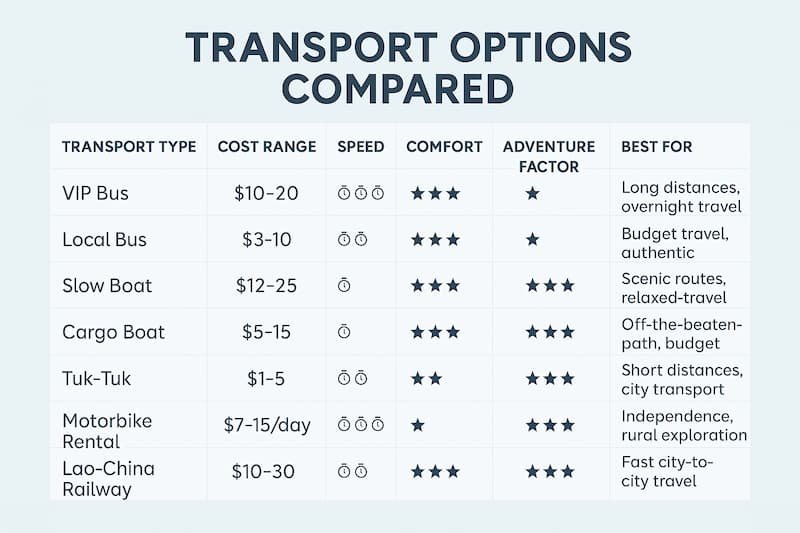
Key Transport Routes
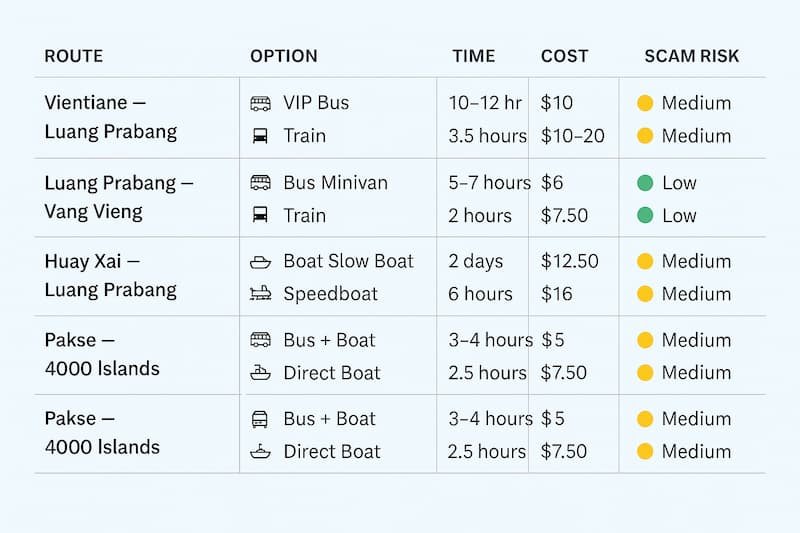
Why Laos’ Transport is Unlike Anywhere Else
- Slow Pace, Lao Style – The concept of “time” is fluid. A 6-hour bus ride can easily stretch to 10, not because of traffic, but because the driver stops for a two-hour lunch with friends.
- Infrastructure? What Infrastructure? – Outside major cities, “paved roads” often mean potholes disguised as asphalt. In the rainy season, some routes simply vanish under mud.
- Cultural Quirks – Want to know why your minivan is suddenly packed with sacks of rice and a live chicken? Because in Laos, everything (and everyone) shares transport.
What You’ll Learn Here (That Other Blogs Won’t Tell You)
This isn’t just another generic “how to take a bus in Vientiane” guide. These Laos Transport Secrets: Survival Tips & Scams to Avoid will arm you with:
- Street-Smart Hacks – Like how to bribe your way onto a sold-out bus (politely) and get thanked for it
- Local Secrets – Why the “slow boat” is a tourist trap (and how to ride Mekong cargo boats for half the price)
- Brutal Safety Truths – Which night buses have 80% theft rates, and how to sleep with your money inside your pillowcase
But here’s the real secret: Laos doesn’t just test your patience—it teaches you to outsmart chaos. These aren’t tips; they’re survival skills from travelers who’ve been pickpocketed, scammed, and stranded… so you won’t be.
Laos rewards the flexible traveler. If you’re ready to embrace the chaos, let’s dive in.
2. The Reality of Transport in Laos: What Most Blogs Don’t Tell You
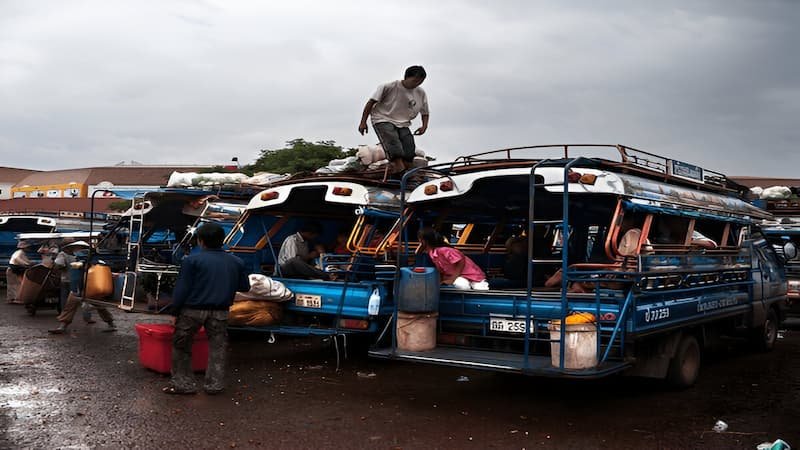
Laos’ transportation system operates by its own unwritten rules—ones that most travel guides gloss over. If you think you can navigate this country like Thailand or Vietnam, prepare for a wake-up call. Here’s the raw, unfiltered truth about getting around Laos.
The “Laos Time” Factor – Why Schedules Are More Like Suggestions
- “10 AM Departure” Means “Maybe By Noon” – Buses, boats, and even domestic flights often leave late, sometimes hours late. Locals don’t bat an eye, but unprepared travelers miss connections.
- The Mystery Stop Phenomenon – That “non-stop” bus? It will pause at roadside stalls, random villages, and the driver’s favorite noodle shop. Always add +30-50% to estimated travel times.
- Why Rushing is Pointless – Laos runs on bo pen yang (“no worries”) time. Fighting it only leads to stress. Better to pack snacks, a power bank, and patience.
The Unofficial Checkpoints & “Fees” – How to Handle Roadside “Taxes”
Welcome to Laos’ shake-down shuffle: where rural ‘officials’ collect creative fees. Don’t panic—just follow these rules.
- The Bribe You Didn’t Budget For – On rural routes (especially near borders), police or local “officials” may stop your bus and demand “fees” (20,000-50,000 LAK / $1-2.50).
- How to Navigate This:
- Keep small bills separate – Don’t flash a wad of cash.
- Play dumb first – Sometimes, they’ll wave you through if you act confused.
- Ask for a receipt – If they’re not legit, this might make them back off.
- When to Just Pay – If it’s a tiny amount, arguing isn’t worth the hassle. Consider it a “local experience tax.”
The Real Cost of “Cheap” Transport – Why Budget Options Can Cost You More
Laos’ budget transport is a masterclass in getting what you pay for—and sometimes less. Before you book that ‘VIP’ bus for $15, know the real price tag.
- The “Sleeper Bus” Nightmare – Those $15 overnight buses? Many are cramped, freezing, and stop at 2 AM for no reason. You’ll arrive exhausted—possibly with a stolen phone.
- Motorbike Rentals: Cheap Until They’re Not – Comes with hidden costs—stolen sleep, and surprise ‘damage’ fees. To prevent this, always:
- Take photos/video of the bike before renting.
- Avoid handing over your passport (use a cash deposit instead).
- Shared Tuk-Tuks: The Squeeze is Real – Paying 10,000 LAK ($0.50) sounds good—until you’re wedged between 15 people and a sack of durian. Sometimes, paying double for space is worth it.
Key Takeaway:
Laos transport isn’t just about getting from A to B—it’s a test of adaptability. The cheapest or fastest option often backfires. But if you plan for delays, keep spare cash for “fees,” and prioritize comfort over price, you’ll survive (and even enjoy) the ride.
3. Unconventional Transport Methods Most Travelers Miss
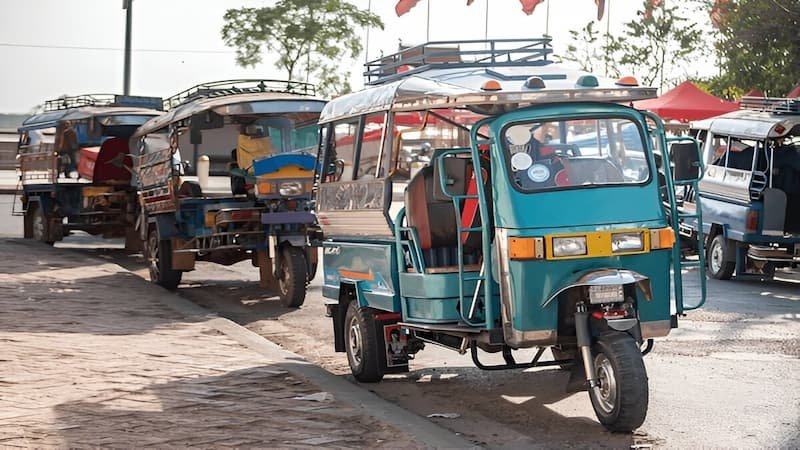
Most visitors to Laos stick to tourist buses, tuk-tuks, and the occasional boat—but if you really want to travel like a local, save money, and have unforgettable stories, you need to think outside the guidebook. These Laos Transport Secrets: Survival Tips & Scams to Avoid introduce the rogue’s gallery of rides that guidebooks won’t recommend—but should.
Here are the under-the-radar ways to get around Laos that most travelers never discover: from hitchhiking with betel-nut-chewing truckers to smuggling yourself onto cargo barges. These aren’t just transport options—they’re backdoor passes to the real Laos, where every journey becomes an adventure and every fare negotiation a story. Master these Laos Transport Secrets and you’ll never travel the same way again.
Hitchhiking Culture – The Unofficial Lao Way to Travel
- It’s Safer Than You Think – Unlike in many countries, hitchhiking in Laos is common and often expected, especially in rural areas where transport is scarce.
- Best Routes:
- Vang Vieng to Luang Prabang (trucks and farmers often pick up travelers).
- The Bolaven Plateau Loop (coffee farmers and motorbikers frequently offer lifts).
- How to Do It Right:
- Wave cash subtly – Drivers often expect a small payment (20,000-50,000 LAK).
- Trucks > Cars – Open-bed trucks are the most common rides, and they’re surprisingly comfortable.
- Learn the Lao word for your destination – Many drivers don’t speak English.
- Best Routes:
- Why Hitchhiking Wins:
✔ Cheaper than tourist transport.
✔ Meet real Lao people (not just other backpackers).
✔ No fixed schedules—leave whenever a ride appears.
Cargo Boats – The Slow Boat’s Grittier (and Cheaper) Cousin
Everyone knows about the Luang Prabang slow boat, but hardly anyone takes cargo boats, even though they’re half the price and twice the adventure.
- Where to Find Them:
- Pakbeng to Houayxay (carries goods but often takes passengers).
- Mekong tributaries in Southern Laos (local traders use these daily).
- What to Expect:
- No seats? No problem. You’ll sit on sacks of rice or bundles of wood.
- Bring your own food & water—these boats don’t have vendors.
- Journeys take longer (stops at every tiny village to unload cargo).
- Why Cargo Boats Beat Tourist Boats:
✔ Pay local price (as low as 50,000 LAK vs. 200,000+ for tourist boats).
✔ Zero crowds—just you and Lao traders.
✔ See parts of the Mekong most travelers never do.
Motorbike Convoys – Safety in Numbers on Remote Routes
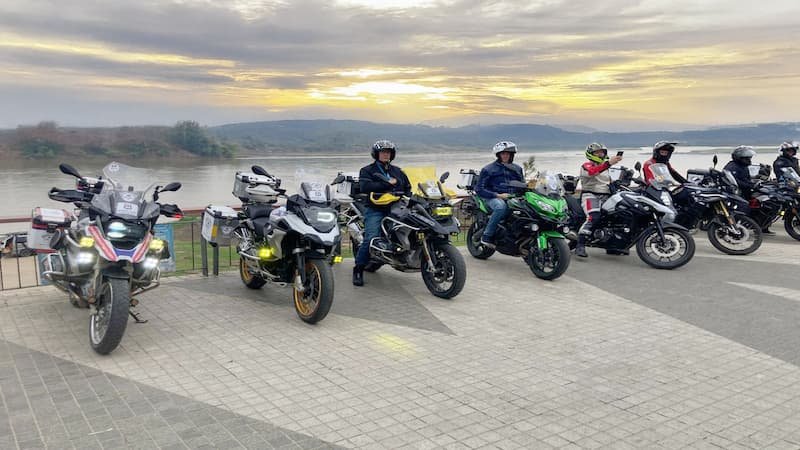
Renting a motorbike alone in Laos can be risky (especially on rough roads), but joining a convoy changes everything.
- How It Works:
- Ask at guesthouses in towns like Thakhek (for the Loop) or Luang Namtha (for northern routes).
- Facebook groups (e.g., “Laos Motorbike Riders”) often organize group rides.
- Why It’s Better Than Going Solo:
- Mechanical breakdown? The group helps.
- Less likely to get scammed by rental shops when returning bikes.
- Local riders know secret shortcuts & best roadside food stops.
- Best Routes for Group Rides:
🚀 Thakhek Loop (safety in numbers on unpaved sections).
🚀 Luang Prabang to Nong Khiaw (avoid landslides with experienced riders).
🚀 The Far North (Phongsaly area) – Where roads are barely roads.
VIP Minivans – The “Luxury” Scam Exposed

Many agencies sell “VIP minivan” tickets for double the price of regular buses, promising comfort and speed. Reality check:
- “VIP” often means:
- A slightly newer van (but same cramped seats).
- No extra legroom (just a sticker on the side).
- Same random stops as cheaper buses.
- When to Actually Book VIP:
- Only if it’s a sleeper van (rare but worth it for overnight trips).
- If you’re traveling during holidays, regular buses get overcrowded.
- The Truth:
🚀 “VIP” is usually a marketing trick.
🚀 Ask to see the van before paying extra.
Key Takeaway:
Most travelers stick to the obvious options, but the real magic of Laos transport happens off the tourist trail. Whether you’re hitching a ride on a vegetable truck, floating down the Mekong with cargo, or joining a motorbike gang, these unconventional methods will save you money and give you stories no one else has.
4. Insider Hacks for Smooth Travel in Laos
Laos doesn’t make transportation easy, but with the right tricks, you can avoid the worst headaches and travel smarter than 90% of visitors. These locally approved hacks will save you time, money, and sanity. These Laos Transport Secrets: Survival Tips & Scams to Avoid reveal the underground playbook that even long-term expats swear by.
From decoding the secret language of bus departure times to bribing your way out of trouble (the polite way), these survival strategies transform frustration into empowerment. Whether you’re facing a mysteriously vanished bus or a suddenly-inflated tuk-tuk fare, our Laos Transport Secrets give you the upper hand in every transport showdown.
Best Times to Travel (Avoid Breakdowns & Delays)
- Early Mornings = Fewer Breakdowns
- Buses and boats that leave before 8 AM are more likely to:
- Actually depart on time.
- Avoid overheating engines (common in midday heat).
- Arrive before dark (critical on sketchy rural roads).
- Pro Tip: Night buses sound efficient, but often arrive at 3-4 AM, leaving you stranded in a strange town with no open guesthouses.
- Buses and boats that leave before 8 AM are more likely to:
- Avoid Rainy Season Surprises (July-Oct)
- “Roads” in places like Bolaven Plateau or Northern Laos turn to mudslides.
- Workaround: Travel right after sunrise when roads are least soggy, or take boats instead of buses where possible.
Secret Booking Tricks (How Locals Do It)
- Facebook Groups > Travel Agencies
- Many Lao bus companies don’t use 12GoAsia or even have websites—they post schedules in groups like:
- “Laos Travel Connection.”
- “Backpackers Laos.”
- Real Example: The Vientiane to Luang Prabang VIP bus is easier to book via a Facebook message to Khop Chai Deu Transport than through agencies.
- Many Lao bus companies don’t use 12GoAsia or even have websites—they post schedules in groups like:
- The “Phone Call” Loophole
- Many buses (especially in the south) only take bookings via phone.
- Ask your guesthouse to call and reserve—they’ll often get a lower price than online portals.
- Buy Tickets On-Site (Sometimes Cheaper)
- Tourist agencies in Vang Vieng/Pakse mark up tickets 20-50%.
- Pro Move: Go straight to the bus station the day before and buy from the counter.
The “Backup Plan” Mindset (Because Things Will Go Wrong)
- The “Never Leave Without a Contingency Fund” Rule
- Always carry an extra 200,000 LAK (~$10) for:
- Unexpected “fees” (Section 2).
- Last-minute guesthouse if your bus arrives at 2 AM.
- Emergency motorbike taxi if your ride no-shows.
- Always carry an extra 200,000 LAK (~$10) for:
- The Guesthouse Shuttle Hack
- Many hostels/hotels offer free pickup from bus stations—if you ask.
- How to Use It: Book 1 night upfront, then ask: “Can your driver meet my bus?” (Works even if you’re staying elsewhere later.)
- The Lao SIM Card Lifesaver
- United or Lao Telecom SIMs (cheap at airports) let you:
- Call bus companies directly for updates.
- Use Google Translate offline to ask locals for help.
- Check Facebook for real-time route changes (e.g., “Landslide on Route 13—take the boat instead”).
- United or Lao Telecom SIMs (cheap at airports) let you:
Transport-Specific Hacks
Buses:
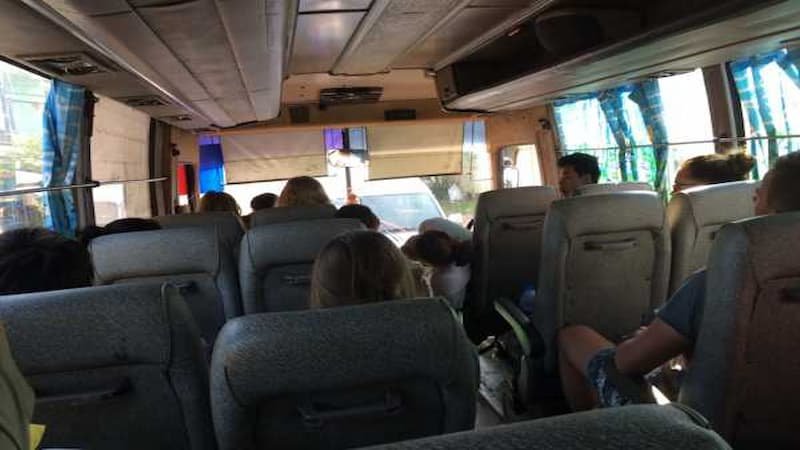
- Seat Selection Matters:
- Avoid the last row (no legroom + bumpiest).
- Left side seats (shade on afternoon trips).
- Bring Toilet Paper & a Sweater:
- “Rest stops” = roadside bushes.
- AC is often arctic-level.
Boats:

- Slow Boat from Huay Xai? Sit in the Back:
- Quieter, less engine smell, and first off at stops.
- Pak Ou Caves Trip? Rent a Private Longtail:
- Costs ~400,000 LAK split 4 ways—faster and no crowds.
Motorbikes:
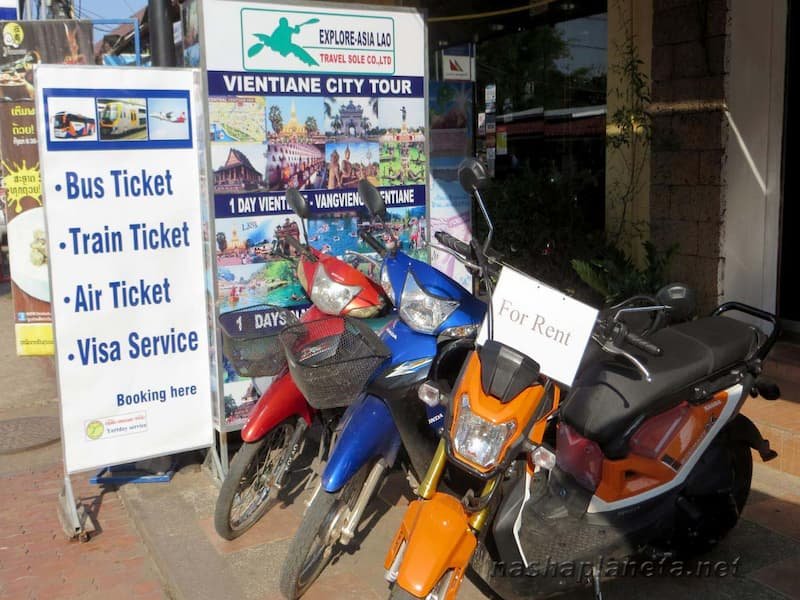
- The “Photograph Everything” Rule:
- Take a video of the fuel gauge, tires, and scratches before renting to avoid fake damage claims.
- Rent in the Afternoon:
- Shops are less busy, so you can negotiate harder.
5. Safety & Scams: What No One Warns You About
Laos is generally safe, but its transportation system has unique risks that most blogs ignore. From highway robberies disguised as checkpoints to motorbike rental shakedowns, here’s what you really need to know to avoid trouble. These Laos Transport Secrets: Survival Tips & Scams to Avoid expose the dark side of Lao travel—knowledge that could save your wallet and sanity.
Most victims get scammed by overlooking simple precautions in this guide. Whether it’s a “VIP bus” that’s anything but luxurious, or a rental shop charging $200 for pre-existing scratches, our Laos Transport Secrets help you spot red flags before they cost you.
Night Buses: The Good, The Bad & The Dangerous

A Laos sleeper bus has berths like the ones in trains. On one side of the bus, there are two berths which are perfect for couples or friends traveling together. On the other side is a single-berth row. Some buses have three rows with single berths in each row. Some sleeper buses have a toilet on board, but not all of them. If a bus doesn’t have a toilet on board, it’ll usually stop around halfway or multiple times for a toilet, snack, and stretch break.
The Risks Nobody Talks About:
- Theft is RAMPANT (especially on the Vientiane–Luang Prabang route).
- How it happens: Thieves board at rest stops and rifle through bags while you sleep.
- How to protect yourself:
- Put valuables in a small bag and use it as a pillow.
- Loop a bike lock through your backpack zippers.
- Avoid putting anything in the overhead racks.
- “Sleeper” Buses Aren’t for Tall People:
- The “beds” are 1.5m long—if you’re over 5’8”, you’ll be fetal-positioned all night.
- Hack: Book a bottom bunk (more legroom) and pay extra for the front row (no seat in front of you).
The Only Safe Night Bus Routes:
- Luang Prabang to Huay Xai (less crowded, fewer theft reports).
- Pakse to Si Phan Don (short enough that you won’t go insane).
Motorbike Rental Pitfalls (How to Avoid $500 “Damage” Scams)
Motorbikes are one of the best ways to get around Laos. Most backpackers prefer it because it allows them to explore, and it’s a much more local way of traveling. Many foreign visitors even bring motorbikes from Thailand, Cambodia, and Vietnam.
You don’t need to get a motorbike for your entire trip around Laos, but it could be the most reliable choice whenever you arrive in the city. For example, you can rent a motorbike in Luang Prabang to visit attractions since another mode of transportation can be expensive or not unreliable or both.
The Classic Scam:
- You rent a bike for $10/day.
- You return it with a tiny scratch.
- The owner demands $200+ for “repairs.”
How to Fight Back:
✔️ Take a 4K VIDEO of the bike before renting (show every scratch, tire tread, even the fuel gauge).
✔️ Never hand over your passport—use a cash deposit instead (max $50).
🚀 Rent from reputable shops (ask backpacker groups for recommendations).
Worst Places for Rental Scams:
- Vang Vieng (especially shops near the bus station).
- Luang Prabang (some shops charge for “pre-existing” engine issues).
Border Crossing Transport Scams
Crossing into Laos? Brace yourself for creative hustles. At the Thai-Lao Friendship Bridge, touts swarm arrivals claiming “no buses for hours!”—a lie to sell overpriced taxis (real local buses cost 20 baht and leave every 30 mins). Golden rule: Walk past anyone offering “help,” head straight to official counters, and keep small bills separate for legit fees.
Friendship Bridge (Thailand–Laos) Tricks:
- “Official Taxi” Mafia – At the Laos side, touts will say:
- “No buses to Vientiane for 3 hours!” (Lie—they leave every 30 mins.)
- “You must take our taxi for 500 baht!” (Real bus price: 20 baht.)
- Solution: Walk past them to the public bus stop (right outside customs).
Vietnam Border (Lao Bao) Scams:
- “You Need a Special Permit!” – Fake officials demand $20+ for imaginary paperwork.
- Truth: The only fee is the stamping charge (~$1-2).
Laos travel is all about stretching your kip – but the real savings start before you even land. While this guide covers ground transport, our Southeast Asia Flight Hacks reveal how to snag $30 regional hops (like Bangkok to Luang Prabang) so you have more cash for epic slow boat trips.
Dangerous Routes (Where Breakdowns = No Help for Hours)
- Route 13 (North of Kasi) – Landslides, zero phone signal.
- Bolaven Plateau backroads – Even locals get stuck in the rainy season.
- Motorbike Routes to Nong Khiaw – Steep drops, no guardrails.
Survival Tips:
- Always carry a power bank (to call for help if stranded).
- Tell your guesthouse your route (so they can alert someone if you vanish).
- Buy a local SIM (United has the best rural coverage).
The “Bribe” Guide (When to Pay & When to Resist)
| Situation | Should You Pay? | How Much? |
|---|---|---|
| Police “fine” for no helmet | Yes (if guilty) | 50,000 LAK |
| Random checkpoint “fee” | No (ask for a receipt first) | 0 LAK |
| Border official “extra stamp charge” | No (insist on the real price) | 0 LAK |
| Motorbike shop “damage” claim | No (show your pre-rental video) | 0 LAK |
Key Safety Takeaways:
- Night buses = high theft risk (lock your bag to yourself).
- Motorbike rentals = video EVERYTHING.
- Borders = walk past touts to find real transport.
- Remote routes = assume no phone signal.
Laos transport isn’t dangerous—it just requires street smarts most travelers don’t have. With these tips, you’ll avoid 99% of scams.
6. North vs. South: Laos Transport Secrets You Need to Know
Laos’ transportation varies wildly by region—what works in Vientiane won’t help you in Phongsaly. Here’s the ultimate breakdown of how to navigate each area like a pro, with local secrets most travelers miss.
Northern Laos (Luang Prabang, Nong Khiaw, Phongsaly)
The Reality:
- “Roads” are suggestions—many routes are unpaved, cliffside paths.
- Shared tuk-tuks stop at every village (even if your destination is “just 10km away”).
Pro Tips:
✔️ Luang Prabang to Nong Khiaw:
- Take the morning minivan (not the boat)—it’s faster and cheaper (80,000 LAK vs. 200,000+ for the slow boat).
- Avoid the “scenic route” in the rainy season (landslides are common).
✔️ Nong Khiaw to Muang Khua: - Only possible by shared tuk-tuk—departs at 6 AM sharp (miss it, and you’re stuck).
- Bring a scarf—dusty doesn’t even begin to cover it.
✔️ Phongsaly (The Wild North): - No buses? Hitch a motorbike taxi—they congregate near the market.
- Fuel stations are rare—top up every chance you get.
Central Laos (Vang Vieng, Thakhek, Savannakhet)
The Reality:
- Tourist buses are overpriced—locals use songthaews (shared pickups).
- The “Thakhek Loop” is overrated unless you love pothole dodging.
Pro Tips:
✔️ Vang Vieng to Thakhek:
- Skip the VIP bus—it’s the same as the cheap one but with AC (which often breaks).
- Songthaews leave from the market (50,000 LAK, but you’ll squeeze between chickens).
✔️ Thakhek Loop Motorbike Rentals: - Rent in town, not at hostels—half the price (try Mad Monkey Motorbikes).
- Avoid the “cave route” after rain—it floods instantly.
✔️ Savannakhet to Pakse: - Take the train! The new Lao-China Railway is faster than buses (but book ahead).
Southern Laos (Pakse, 4000 Islands, Bolaven Plateau)
The Reality:
- Boats > Buses—the Mekong is your highway here.
- “Express boats” are anything but—they stop constantly.
Pro Tips:
✔️ Pakse to Don Det (4000 Islands):
- Don’t take the speedboat—they’re dangerous (and drivers are often drunk).
- Slow boat leaves at 8:30 AM (100,000 LAK, includes pickup from your hostel).
✔️ Bolaven Plateau Coffee Farm Tours: - Rent a motorbike—tour vans skip the best spots.
- Stick to Route 20—other “roads” disappear in the rainy season.
✔️ Border Crossing to Cambodia: - Ignore the “VIP taxi” touts—the local bus costs $3 and is just as fast.
The New Lao-China Railway (Game-Changer or Scam?)
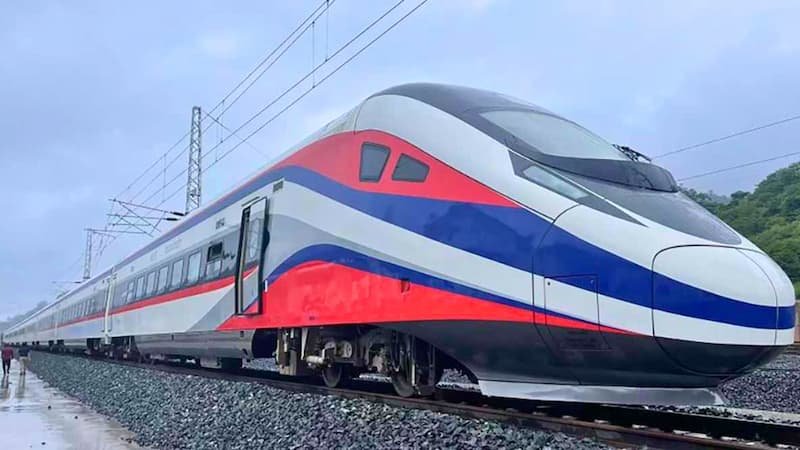
What They Don’t Tell You:
- It’s not cheap—Vientiane to Luang Prabang costs 200,000 LAK (same as a VIP bus).
- Tickets “sell out” but aren’t really sold out—go to the station and ask for standing room (they’ll usually find you a seat).
Best Routes for Trains:
- Vientiane to Vang Vieng (only 1 hour, beats the hellish bus ride).
- Luang Prabang to Boten (China border)—if you’re heading to Yunnan.
Key Takeaways for Each Region:
| Region | Best Transport | Worst Transport | Local Secret |
|---|---|---|---|
| North | Shared tuk-tuks (morning only) | Night buses (theft risk) | Hitchhike with truckers |
| Central | Songthaews (market pickup) | VIP buses (fake “luxury”) | Train for long distances |
| South | Slow boats | Speedboats (dangerous) | Motorbike the Bolaven Plateau |
Final Tip: Ask “Baw Pen Nyang?” (No Problem?)
If you’re unsure about a route, ask a local:
- “Bus [destination] mee baw?” (Is there a bus to [X]?)
- If they shrug and say “Baw pen nyang”, it means “Maybe, but don’t count on it.”
7. Final Pro Tips & Resources – Mastering Laos Transport Like a Pro
You’ve made it through the chaos—now it’s time to put these insights into action. Here’s your ultimate cheat sheet for navigating Laos’ transport system, plus the best apps, groups, and phrases to survive the adventure.
Essential Lao Phrases for Transport
| Lao Phrase | Pronunciation | When to Use |
|---|---|---|
| “Let tauk-tauk bpai [destination] tao dai?” | “Loat took-took bye [X] tao die?” | “How much for a tuk-tuk to [X]?” (Avoid overpaying) |
| “Kee-a neung bpai [town] mee baw?” | “Key-uh nung bye [X] mee baw?” | “Is there a bus to [X]?” (Ask at markets) |
| “Yang bpai!” | “Yung bye!” | “Let’s go!” (Yell this if your driver naps too long) |
| “Baw sai nam tan!” | “Baw sigh nam tahn!” | “No sugar!” (For your roadside coffee stop) |
Must-Have Apps & Websites
- Google Maps (Offline) – Download Vientiane, Luang Prabang, Pakse for offline use.
- 12GoAsia – Book some Lao buses/trains—but double-check via phone/Facebook.
- Facebook Groups:
- “Backpackers Laos” – Real-time updates on road conditions.
- “Laos Motorbike Rentals & Routes” – Mechanic recommendations.
- United SIM Card – 3G coverage in remote areas—critical for checking routes.
Packing List for Lao Transport
- Toilet paper + hand sanitizer (Bus “rest stops” = bushes).
- Power bank (Outlets are rare, even on “VIP” buses).
- Earplugs + eye mask (For overnight trips with blaring Lao pop music).
- Lock + cable (Secure your bag to the seat on night buses).
- Printed hostel address (Many taxi drivers can’t read Google Maps).
Last-Minute Hacks
- Lost? Find a “lottery stand” – Sellers always know bus schedules.
- Need a boat? Ask at dawn – Captains leave early; miss it and you’re stuck.
- Motorbike broken down? Wave down a “tuk-tuk mechanic” (They’re everywhere).
Key Mindset: “Baw Pen Nyang” (No Problem)
Laos transport will test your patience—but that’s part of the fun. Embrace the chaos, laugh when your bus stops for a 2-hour lunch, and remember:
- Delays = Stories.
- Breakdowns = Unexpected Adventures.
- Scams = Lessons.
Now go forth—armed with these tips, you’re 10x more prepared than the average traveler.
Further Resources
- Best Motorbike Rental Shops: Mad Monkey (Thakhek), Sengchalean (Luang Prabang).
- Reliable Bus Companies: Khop Chai Deu (Vientiane), Pakse Travel (South).
- Train Updates: Official Laos-China Railway site (but confirm via Facebook).
These Laos Transport Secrets: Survival Tips & Scams to Avoid turn chaos into stories. Remember: Patience and preparation beat ‘VIP’ tickets every time.
Safe travels—and may your buses leave (almost) on time!
Your tips save lives! Did you discover a hidden cargo boat route or outsmart a rental scam? Share your Laos transport hacks in the comments to help fellow travelers avoid costly mistakes.

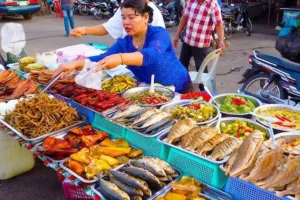

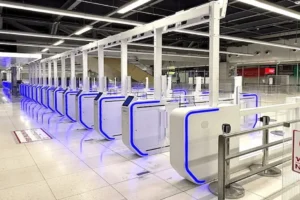




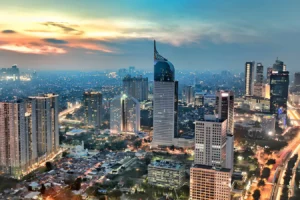


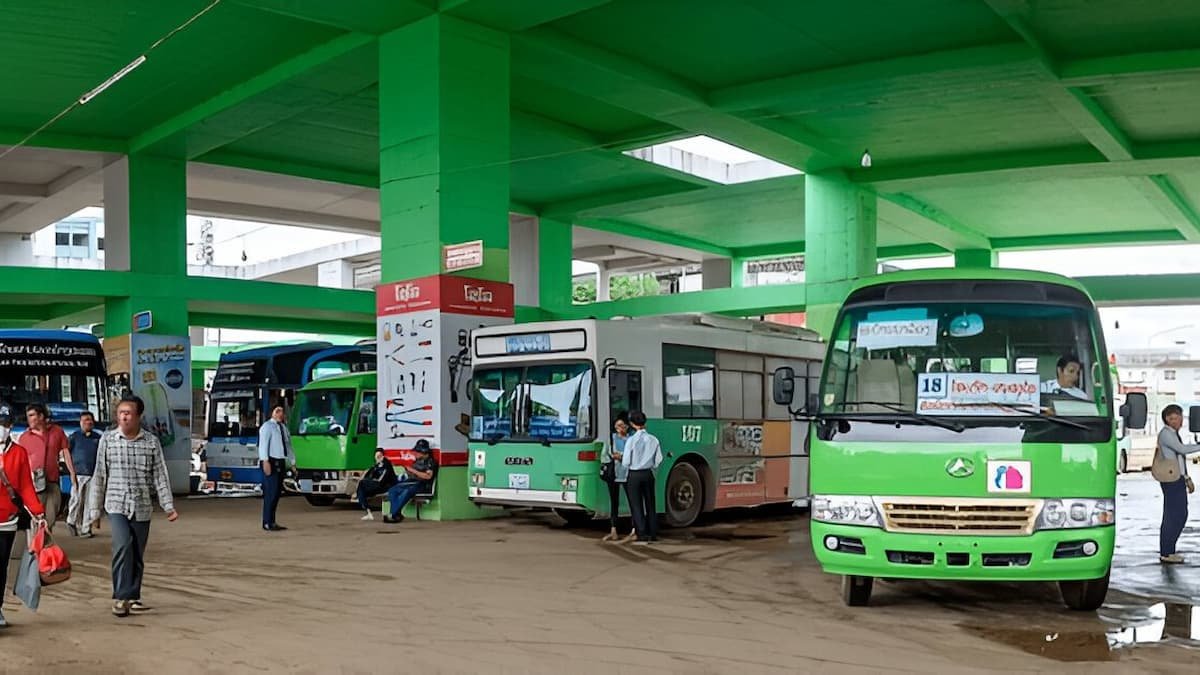
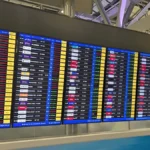


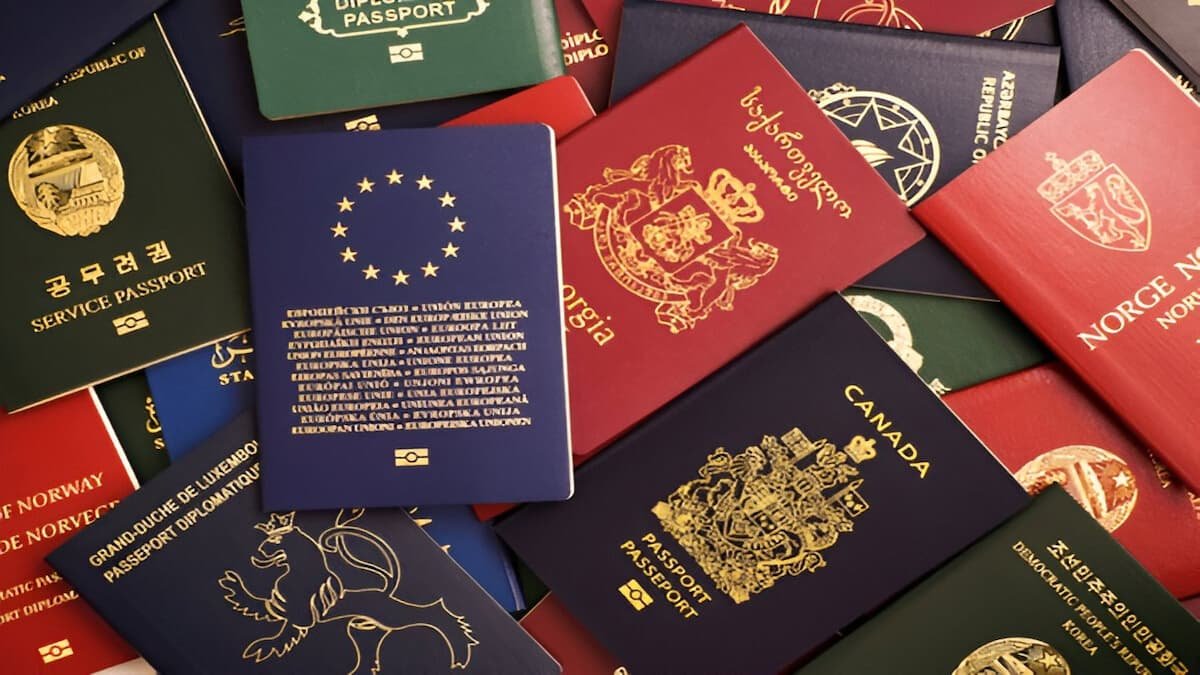
Thanks for sharing. I read many of your blog posts, cool, your blog is very good. https://accounts.binance.info/vi/register-person?ref=MFN0EVO1